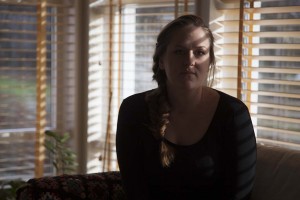
Portraits are probably the biggest and most important discipline in photography.

This is the image when just pointing and shooting, letting the camera do the work. Expose for the skin of the motive. (Klick on any image for large size).
There is not one single recipe for good portraits. If you are shooting an old man you may want to highlight wrinkles and details in the skin, while young women often are edited too look as beautiful and flawless as possible. But please feel free to break all conventions.
There are some general aspects you need to consider in order to create a good portrait.
- The technique. Good lighting and the right depth of field.
- The motive. The person should have the right poses and feel comfortable during the session. And a beautiful person is likely to produce more likes on Instagram and other social medias.
- The environment. The surroundings can sometimes say more about the portrayed person. We all exist in a context.
- The light is crucial in all aspects of photography. After all, we say that photographers are painting with light.
- Post processing in a good image editing software is immensely important in portrait photography, regardless whether you are shooting a young woman, an old person or a child.

Using a reflecting screen and over expose with 0,75 f-stops. The cover image is the same, except that I used a Speedlight to enlighten the shadows.
You should have a really good portrait if you can get it right in all these aspects. To succeed you need a good idea for the portrait. Planning and preparation will help you get there.
How to get a winning concept for a portrait?
Many of us are just shooting wildly until we finally manage to get a good enough image. Starting with one part of a concept for the image and then figure out the rest in order to get an amazing portrait is often better.
Place

The kitchen can work, especially if cooking is an interest with the person portrayed. This is also an “active” pose.
If you know the perfect set for a portrait it is easier to figure out the rest.
Who is the perfect person to photograph here? One or two children? A young and beautiful woman? An old hunter?
Next question is when? Normally the best light is in the morning or evening when the light is soft and low. If you are shooting in black and white you may prefer the even light on a cloudy day. Or why not in darkness, which will allow you to set the lighting exactly as you like it.
You should also consider exactly how much you want the surroundings to show. Even with a short depth of field the environment is important for the concept. With access to a studio you can even create the entire environment if you are ambitious.
But no place I can think of is off limits for photography. The kitchen is a good setting for someone interested in cooking, The car, garage, even the toilet can also be a good place for a portrait.
I have a number of places stored in my mind for future portraits, even time of year and day is noted.
Person

Here is an active image where we tried to remove most of the face and focus on the eyes. Two Speedlites and normal exposure.
Normally you start with the motive, the person to be portrayed. If you know whom to shoot you should ask yourself how the person would look his or her best. Black and white or colour? Full figure or not? Is there a place that will say something more about the person and her or his personality?
If the image should be romantic you may like a setting with a beautifully set table and candles or a place in the countryside with the sunset in the background. To get the right light you then should use flashes and long exposure. Put the camera on a tripod and expose for one or a few seconds to get the candles right and the face sharp. For another concept you may prefer a tougher setting like the hockey changing room or a boxing ring. Don’t forget to bring a spray bottle with water to create sweat.
When you have a good setting and props you should make sure the clothing is right. Avoid too garish clothes. After all, it is probably the person you are portraying, not the clothes.
Posing

A long exposure can give a better light, especially with live candles. Here we turned of the lamps and used a couple of Speedlite flashes to freeze the image and make the face sharp. Exposing for about a second created a better background and gives some reflected light from the screen on the computer.
There are a number of different ways to think when planning the shoot. Here are some criteria for your consideration ans some tips regarding instructing your model.
Experiment with different poses. A person can look very different depending on posture; even a slight angle to a face can make a huge difference.
Smiling almost always results in a better image, since it gives much more positive vibrations than serious faces do. Some people can be instructed, but it’s allways good to have a joke ready. Just in case. It is also better if you can focus on your motive, talking and joking, keeping your model happy and comfortable insted of concentrating on the equipment when working.

Even the smallest difference in pose can make a huge difference. And the result is always individual for each model. All these images were taken with only a reflecting screen.
“Stomach in, chest out” actually works on image, even though it looks constrained and weird in reality.
Pressing the tongue against the roof of the mouth also works, unless the people have a real double chin. There are no quick fixes for that… Hmm, maybe Photoshop?
Male or female? Traditionally women models use special poses that I personally often find unnatural. Typically standing a bit from side with most of the weight on one foot, in order to expose curves and lines, also often touching their body, for instance the throat or breast. Examples of male poses are broad legs and arms crossed. If you like you can change gender paradigms, letting a woman posing like a man and the opposite. You should have an idea about why, regardless of what you choose for your model.
Open or closed? Should the portrayed person seem inviting or as if he or she is keeping the distance? Remember the purpose of the image when positioning you model. A closed position is for instance arms and legs crossed, an open would be the opposite.
Full figure or not? A full figure pose allows you to use the body language. A beautiful body can also have an esthetical value in its self, but full figure also takes away the focus from the face. How the image is going to be presented is of great importance for the choice.
Active or passive? Most portraits is taken in a passive mode. The portrayed person is usually not doing something apart from being photographed. But there are no laws against letting the person do something when the image is taken. A classical example of an active pose is someone jumping, but it can be any movement or task.
Authority or relaxed? We have all seen power images, especially of men. Arms crossed and image taken a little bit from below. Informal should express a more private and friendly position.
Formal or informal? There are advantages and disadvantages for each alternative. This is a matter of clothing and setting, but also what pose you choose.
Watch out for the hands! A hand is almost as big as a face and uncomfortable hands can ruin a good portrait. Use props or have alternative suggestions ready.
You can also experiment by removing essential parts of the motive. An image can be very interesting even if all you can see is the eyes of the person portrayed.
Problem
A situation that the viewer can identify himself with can also be a good ground for a portrait. It’s an advantage if it has a connection to the person but doesn’t necessary have to be related to him or her. The situation itself can also be the motive with your motive in the car, behind the wheel or on the motorbike. But please, avoid experiment with photo-shoots in 190 kilometres per hour.
Another way of creating interesting portraits can be to place people in the wrong environment. The prom queen in the wilderness, the hunter, fully equipped with dog and rifle, in the TV coach and so on.
Props is often also very useful, preferably something that ads to the final portrait. What would Hemmingway be without his hat and typewriter? Sometimes props can also be helpful making the person more comfortable with the situation, especially when shooting children.
There are no limits for the imagination. Everything is allowed as long as the final image turns out well.
Presentation

Here is an example of a poor photography saved by editing. Black and white can make wonders, especially if the clothing have bright colours and don’t match. A distracting background can if necessary be removed.
Post processing is very important in portrait photography. Try different editions, colour or black and white, soft or hard light and so on.
For beauty photography you may like to over expose a little. Less sharpness and brilliance is usually preferred. Soften the wrinkles around the eyes and corners of the lips. Weather-beaten old men are often best portrayed in black and white with lots of sharpness, highlighting every little wrinkle and beard bristle.
In general it good to add some vignette, enlighten light images or darken less bright backgrounds in order to highlight the portrayed person.
It is also a good idea to create different versions for different medias. If you intend to share you image through social media like Instagram. You may want to iconify the image for the small format in mobiles. For instance increasing contrast to make the motive clearer. For larger formats it may be necessary to remove pimples or wrinkles even more. Maybe you have a collection of black and white images on the wall back home, and so on.
If you for once manage to make a really good image, don’t settle for posting it on Instagram and then move on. It may be a nice gift if you make it in a large format and frame it. Remember that even though your living room don’t have as large an audience as Instagram, the image will be seen by many in time. And you will be able to be there for the response.
It’s not that often we manage to produce something really good and unique. So when we finally do we should celebrate with champagne and invite everyone we know to come and watch the image. Above all it deserves our best effort in post processing and a better place than number 5 005 679 in the feed for #instagood on Instagram.
Your equipment
A light sensitive lens is good to have for shorter depth of field. A 40 or 50 mm lens is nice to have and a portrait telephoto lens (80 – 135 mm) is perfect, especially for outdoor shooting. A couple of flashes is also good to have and a reflecting and diffusing screen is indispensable.



